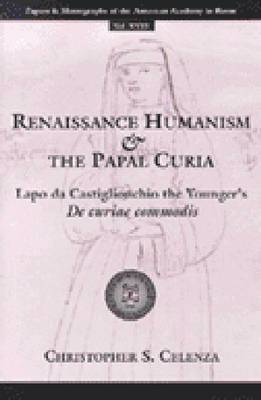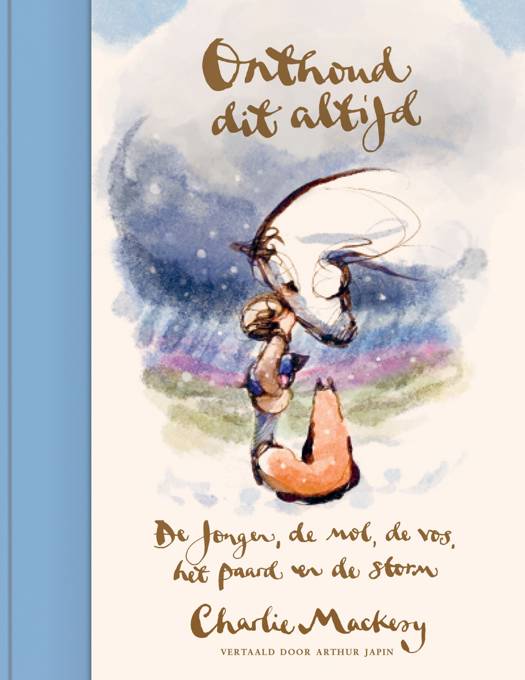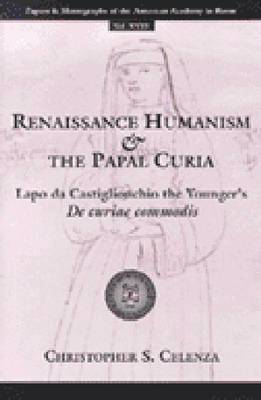
Je cadeautjes zeker op tijd in huis hebben voor de feestdagen? Kom langs in onze winkels en vind het perfecte geschenk!
- Afhalen na 1 uur in een winkel met voorraad
- Gratis thuislevering in België vanaf € 30
- Ruim aanbod met 7 miljoen producten
Je cadeautjes zeker op tijd in huis hebben voor de feestdagen? Kom langs in onze winkels en vind het perfecte geschenk!
- Afhalen na 1 uur in een winkel met voorraad
- Gratis thuislevering in België vanaf € 30
- Ruim aanbod met 7 miljoen producten
Zoeken
Renaissance Humanism and the Papal Curia
Lapo Da Castiglionchio the Younger's de Curiae Commodis
Christopher Silvio Celenza
€ 115,95
+ 231 punten
Omschrijving
Renaissance Humanism and the Papal Curia offers first a general introduction to the life and work of Lapo da Castiglionchio. Then a facing-page translation of and commentary on Lapo's complicated treatise, De Curiae Commodis, are offered. These illuminate both the text itself as well as Lapo's own situation and the humanistic era that De Curiae Commodis addresses.
Born into a family of the feudal aristocracy in 1406, Lapo da Castiglionchio as an adult was a practitioner of the new art of humanism. A student and friend of noted humanist Francesco Filelfo, Lapo long sought admittance to the powerful circle at the Vatican's pinnacle. He failed in that goal but left us a document full of valuable details about the workings, goals, and interests of the papal curia. In the year he died, Lapo wrote the treatise De Curiae Commodis. This work is written elegantly, learnedly, and angrily. It is a human document alive with information for intellectual, social, and cultural historians.
Christopher S. Celenza is Assistant Professor of History, Michigan State University, and has been elected a Fellow of Harvard University's Renaissance Study Center in Florence, the Villa I Tatti, for the next academic year (Sept. 1999-June 2000).
Born into a family of the feudal aristocracy in 1406, Lapo da Castiglionchio as an adult was a practitioner of the new art of humanism. A student and friend of noted humanist Francesco Filelfo, Lapo long sought admittance to the powerful circle at the Vatican's pinnacle. He failed in that goal but left us a document full of valuable details about the workings, goals, and interests of the papal curia. In the year he died, Lapo wrote the treatise De Curiae Commodis. This work is written elegantly, learnedly, and angrily. It is a human document alive with information for intellectual, social, and cultural historians.
Christopher S. Celenza is Assistant Professor of History, Michigan State University, and has been elected a Fellow of Harvard University's Renaissance Study Center in Florence, the Villa I Tatti, for the next academic year (Sept. 1999-June 2000).
Specificaties
Betrokkenen
- Auteur(s):
- Uitgeverij:
Inhoud
- Aantal bladzijden:
- 264
- Taal:
- Engels
- Reeks:
- Reeksnummer:
- nr. 31
Eigenschappen
- Productcode (EAN):
- 9780472109944
- Verschijningsdatum:
- 12/01/2000
- Uitvoering:
- Hardcover
- Formaat:
- Genaaid
- Afmetingen:
- 161 mm x 237 mm
- Gewicht:
- 498 g

Alleen bij Standaard Boekhandel
+ 231 punten op je klantenkaart van Standaard Boekhandel
Beoordelingen
We publiceren alleen reviews die voldoen aan de voorwaarden voor reviews. Bekijk onze voorwaarden voor reviews.









